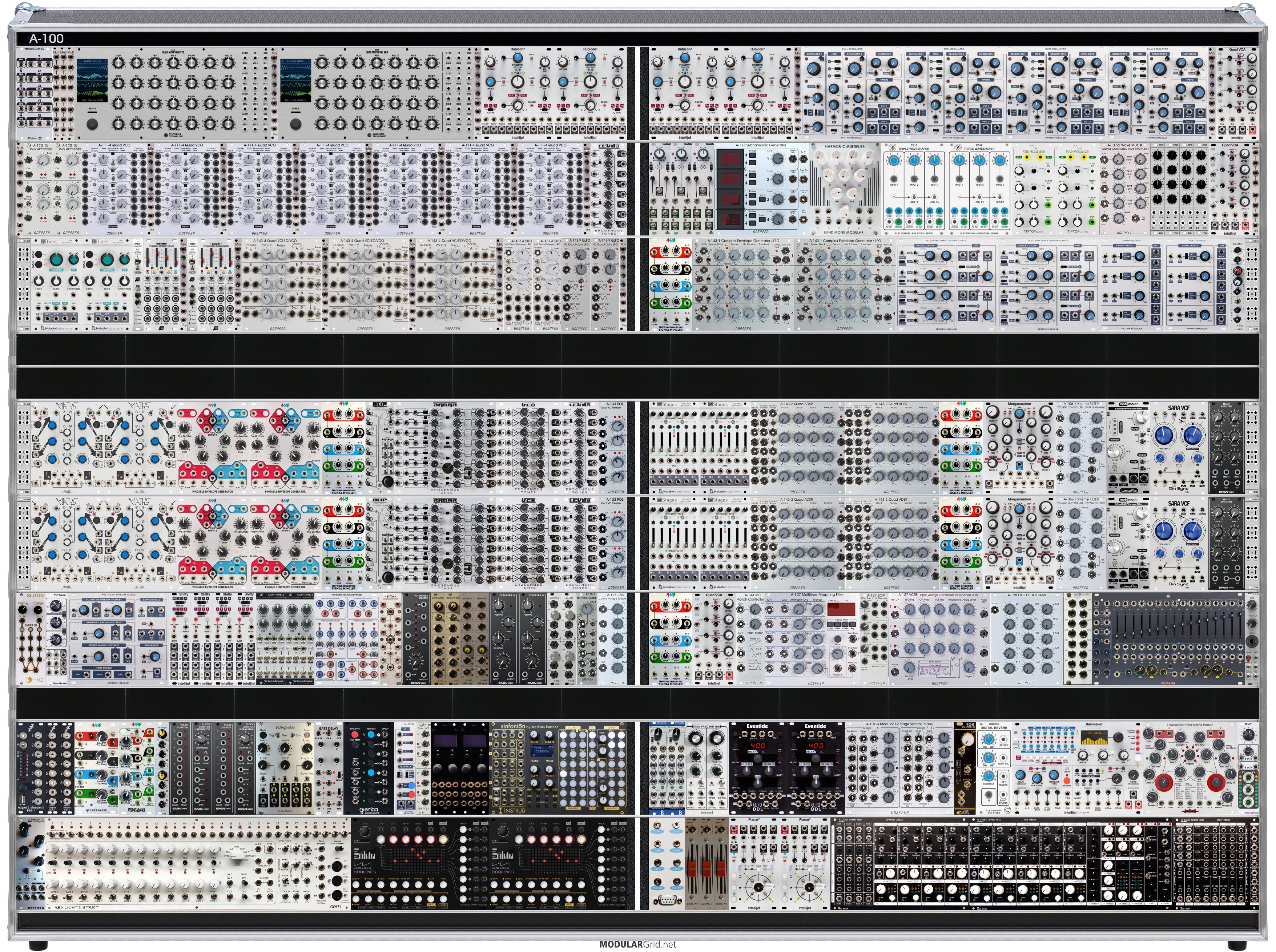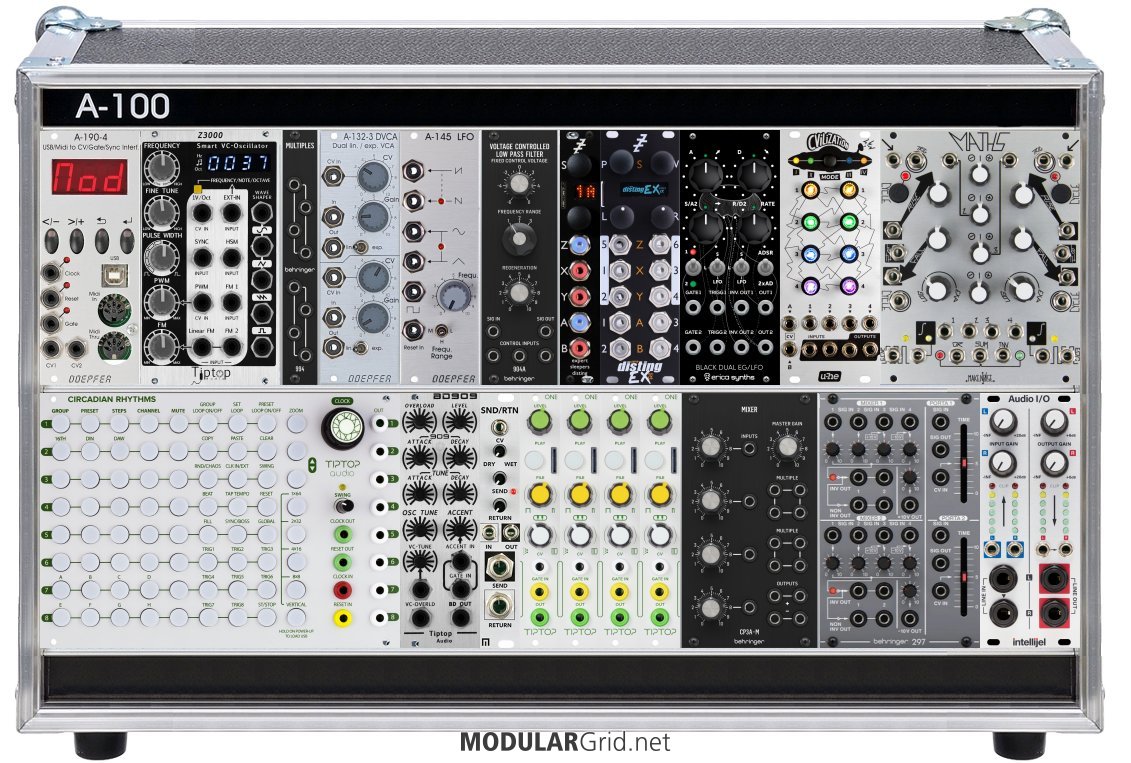Synth wall, eh? 50k budget or so, hm? Ooooooooookay...this build uses four Doepfer 9U Monster Cases and two Doepfer Monster Case Bases.

Now, the first thing you'll notice immediately is a lot of repetition in the modules. This is very deliberate. When you're building on THIS scale, what you want is to pick what would make sense in, say, a Pittsburgh EP-420, and then repeat this over and over so that you can generate a very massive, complex sound, but at the same time you don't wind up getting utterly lost on the patch panel. You know what all the devices are, and their location is all grouped so that each set of modules functions as a singular unit. This is why you also see a lot of 2hp Mixers interspersed throughout the VCOs and LFOs. Each brace of four devices can be easily summed-down into a much more complex signal. And where there are four devices in a module, these modules get their own mixer, allowing for extremely complex admixtures of waveforms. In other places, multiple modules exist to service other sets of multiple modules, such as you see on rows 3-5, right cabs.
So, the top two rows are 'voicing'. There are a total of forty-eight oscillators, although in the case of the VCOs in the Sputnik Duals, one of each will be used as an audio modulation source by default due to that module's architecture. Each oscillator section also has its own summing mixer. The top row (which also contains the buffered mults and passives for CV distro) is summed at a Quad VCA, so each submix group has VCA dynamic control. Row two, left cabs sums with an mixer that can split into either 8-1 or 4-2, with inversion possibilities. This section also contains four slew limiters, located near the CV mult/distro section above. Row two, right cabs is waveshaping: three ring mods, a subharmonic generator, harmonic multiplier, two Elby triple waveshapers, two Tiptop Folds, a Doepfer A-137-2 waveform animator, and four active Moog CP3 clones, which then sum down further via another Quad VCA.
The functions on row three are split. Left cabs is the LFO section, right is a SISM, two A-143-1s which can function as AD envelopes or as complex function generators. Two more sets of quad FGs are to the right of those, feeding a pair of quad LPGs. The Pan/Mix on the end allows summing of or crossfading between the main mix outputs of the quad LPGs if needed.
Rows four and five, left cabs are all complex modulation sources, with more SISMs, 16 linear VCAs (summable) and more 8-1/4-2 mixers as seen above for complex modulation source mixing. At the end of this section are four VC Polarizers for inversion/modulation of summed modulation signals.
Rows four and five, right cabs contain the complex envelopes (four Stages, four Quad ADSRs) and SISMs for envelope mixing. Then the filters take up the rest of this section. Each filter subrow is duplicated, but filters can be broken out of this and/or interconnected as needed. A pair of formant filters is in place for the Doepfer A-106-1 resonance inserts, although it's possible to also use the EMW Multi Bandpasses for this as well. Note that the primary filters in this build are filter pairs, which can allow for further breakout of filtering functions as well as complex interpatching for elaborate timbral behavior.
Row six is where the architecture of the build starts changing. The first few modules are random sources; the HN EQ by the Sputnik random source is for VC noise coloration, so that the noise distribution can be modulated and changed for the WCRS's use. Four Shiftys are after this for arpeggiation of the WCRS's sample and hold or, just as easily, arpeggiation across any sampled source. Up to sixteen discrete stages of analog shift registers are available if all four Shiftys are patched in series. Four window comparators follow for complex gate/trigger extraction from modulation curves. After this, an ARC Artificial Neural Network handles complex logic functions over gate/trigger behavior for timing complication. The Bytom is a gate/trigger integrator. This is followed by more gate/trigger extraction modules, then CV manipulators (two Ladik minimum/maximums and two EMW manual CV folders). At the end of this section, four linear VCAs are in place, along with a CV adder and a triple DC offset source.
On the right cabs side of row six are, first, more CV processing (SISM, Quad VCA, and a Doepfer Morph Controller), but then the rest of the row is taken up with what could be termed 'master' filters for overall timbral processing. The last of these is a Frap Fumana, which allows complex vocoder processing of synth audio; a Thonk version of a Doepfer A-119 (not in production just yet) is next to the Fumana for inputting external audio as well as envelope following and gate extraction from signal dynamics.
Row seven is the angled row in the Monster Case Bases. On the left is the MIDI interface, an Expert Sleepers FH-1 plus two expanders for a total of 24 CV/gate outputs from this. This was chosen so that any USB-capable MIDI controller can be plugged directly into the system, but it is also possible to use an external MIDI box to send computer-sequenced MIDI into the system. The next several modules are all for the purpose of generating time modulation in various ways. Three different sequential switches are next, all of slightly different types and usages. Quantizing and similar functions are after this, with two o&C builds plus an Instruo Sinfonion for polyphonic quantizing and harmony generation. Naturally, all of these devices are intended to work either separately or in tandem functions.
The right cabs side of row seven is audio processing: dynamics, frequency-shifting, delays, a Doepfer A-101-3 modular phaser, a Juno-106 chorus clone and an Elby digital reverb, with these last two being mono-to-stereo capable. A Rainmaker delay and Jomox T-Rackonzier close this out with complex effect processing, and the output module is at the far right, keeping the external cable draping similar to that found on the left side.
Row eight is the MCBs' 'flat' row. A complex master clock is here, which can also take clocking from the FH-1 or can also be CV controlled for time modulation. Then sequencers: one traditional 'row' type, and two multichannel Eloquencers. Right side has controllers first: ribbon controller interface, three assignable CV fader controls, two joysticks. The ultimate 'controller', however, occupies the rest of the row; this is a full ADDAC VC mixer system, with three AUX busses, CV control over dynamics and panning as well as numerous other functions.
This system, as I noted, is intended for use with an external controller, with either CV/gate or USB being acceptable input methods for control signals. Controller should optimally be placed in proximity to the mixer and ancillary control modules.
Current needed for the whole system is 12051 mA on +12, 8066 mA on -12, and 181 mA on 5V, which should be within the distributed supply capacities of all six cabs with Doepfer PSU-3 supplies. Total module expenditure estimate by MG is $47,655.00.
That was fun...



